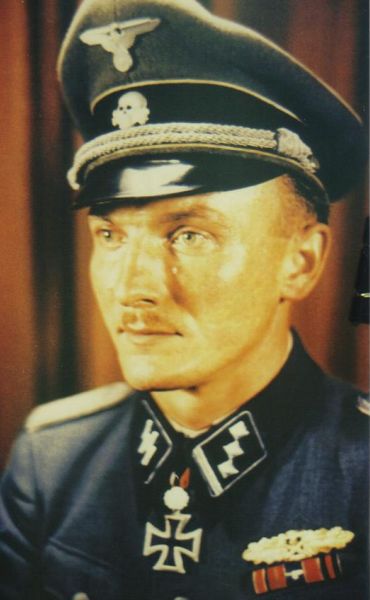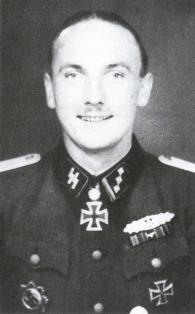Hinz, Bruno (Waffen SS)
- Date of birth:
- August 28th, 1915 (Petersdorf, Nordhausen/Saxony, Germany)
- Date of death:
- February 28th, 1968 (Munich/Bavaria, Germany)
- Service number:
- SS-Nr.: 313.698 // NSDAP-Nr.:
- Nationality:
- German (1933-1945, Third Reich)
Biography
01.10.1936: 10./ SS-Standarte „Deutschland" in München
00.05.1940: WIA
21.09.1940: promoted to SS-Unterscharführer
00.12.1940-00.03.1941: SS-Ersatzbataillon „Deutschland"
00.04.1941: SS-Junkerschule Braunschweig
00.10.1941: SS-Scharführer, 5. SS-Panzer-Division „Wiking"
30.01.1942: promoted to SS-Untersturmführer, Führer, 2./ SS-Panzer-Grenadier-Regiment „Westland"
00.04.1943: SS-Ustuf, Kommandeur, 10./ SS-Panzer-Grenadier-Regiment „Westland"
00.05.1943-00.07.1943: WIA, SS-Regiment der mechanischen Infanterie in Klagenfurt
00.08.1943: SS-Ustuf, Kommandeur, 10./ SS-Panzer-Grenadier-Regiment „Westland", 5. SS-Panzerdivision 'Wiking'
00.09.1943: severely WIA - Lazarett
09.11.1943: promoted to SS-Obersturmführer
00.02.1944: SS-Ostuf, Führer, 2. Kompanie, SS-Panzergrenadier-Regiment 38, 17. SS-Panzergrenadier-Division 'Götz von Berlichingen'
05.09.1944: SS-Junkerschule Bad Tölz
09.11.1944: promoted to SS-Hauptsturmführer
20.01.1945: SS-Hstuf, Bataillonskommandeur, 17. SS-Panzergrenadier-Division „Götz von Berlichingen"
31.03.1945: US POW
Do you have more information about this person? Inform us!
- Period:
- Second World War (1939-1945)
- Awarded on:
- May 1940
- Period:
- Second World War (1939-1945)
- Rank:
- SS- Rottenführer (Corporal)
- Unit:
- 10. Kompanie, SS-VT-Standarten "Deutschland"
- Awarded on:
- June 16th, 1940
- Period:
- Second World War (1939-1945)
- Rank:
- SS-Untersturmführer (2nd Lieutenant)
- Unit:
- Zugführer, SS-Regiment "Westland", SS-Division "Wiking"
- Awarded on:
- December 2nd, 1941
- Period:
- Second World War (1939-1945)
- Awarded on:
- 1942
- Period:
- Second World War (1939-1945)
- Rank:
- SS-Untersturmführer (2nd Lieutenant)
- Unit:
- Kompanieführer, 2. Kompanie, I. Bataillon, SS-Panzergrenadier-Regiment 10 "Westland", 5. SS-Panzergrenadier-Division "Wiking", Waffen-SS
- Awarded on:
- April 17th, 1943
- Period:
- Second World War (1939-1945)
- Awarded on:
- April 1943
- Period:
- Second World War (1939-1945)
- Rank:
- SS-Untersturmführer (2nd Lieutenant)
- Unit:
- Kompanieführer, 2. Kompanie, SS-Panzergrenadier-Regiment "Westland", 5. SS-Panzergrenadier-Division "Wiking"
- Awarded on:
- May 20th, 1943
- Period:
- Second World War (1939-1945)
- Rank:
- SS-Untersturmführer (2nd Lieutenant)
- Unit:
- Führer, 2. Kompanie, SS-Panzergrenadier-Regiment 10 "Westland", 5. SS-Panzer-Division "Wiking"
- Awarded on:
- December 2nd, 1943
“At the start of September 1943, during our great retreat movement southwest of Kharkov, the enemy committed fresh infantry and tank forces supported by artillery of all calibers and Katyushas. Using all means, they tried to break through our front towards Poltava in order to cut off the retreat route of our forces to the southeast.
In the course of the retreat, and as a result of the weeks-long and uninterrupted strong enemy pressure, the Regiment had occupied an unfavourable position north of the Kharkov—Poltava railroad between Bf. Schljach and the village of Bortschany.
The 2./SS-Pz.Gren.Rgt. Westland, under the command of SS-Untersturmführer Bruno Hinz, was positioned just before the village of Hf. Buzkij in a rough patch of terrain. It had been heavily weakened by the hard fighting of the previous days.
After reorganizing their troops, and following an extremely heavy barrage by weapons of all calibers including Katyushas and ground-attack aircraft, the enemy launched multiple attacks against the sector of the 2./SS-Pz.Gren.Rgt. Westland with strong infantry and tank forces. However, in the face of hard close combat and ruthless resistance by SS-Untersturmführer Hinz and his men (who were inspired to achieve the most that they could by their commander’s personal example), these attacks were repulsed with heavy losses.
Over the course of these repeated hostile attacks there were significant losses of men and weapons on our side, and contact with the neighbouring units and the battalion command post was interrupted for a long time.
Clearly recognizing the consequences of an enemy breakthrough in the direction of Walki, and that he could only rely on his own means to stop it, Hinz reorganized the remnants of his Kompanie in a strongpoint-like fashion so as to once again be ready for defense.
With these independently implemented measures, as well as his multiple personal interventions at various enemy penetration locations (where he would always throw himself at the head of a few men against the broken-in enemy), he was able to repeatedly fend off the powerful breakthrough attempts of the enemy. In this time he would often personally take the place of exhausted friendly machine-gunners.
During a renewed attack the enemy succeeded in getting into the rear of the 2./SS-Pz.Gren.Rgt. Westland by pushing past the open flanks of the Kompanie. While the bulk of the Kompanie continued to defend against frontal attacks, Hinz once again took up position at the head of a few men and charged into battle against the enemy in his rear. He succeeded in smashing this contingent in bitter close combat. The personal bravery of SS-Untersturmführer Hinz inspired his men to ever higher achievements of their own. During another strong enemy attack they let the hostile tanks overrun them before completely smashing the following infantry.
In all this time SS-Untersturmführer Hinz displayed extreme determination in the defense and exemplary bravery, while repeatedly launching fierce counterattacks on his own initiative that brought the enemy significant casualties. These efforts enabled the Bataillon to reorganize and occupy a coherent front over the course of a few hours, which in turn ultimately led to the prevention of a potential enemy breakthrough.
SS-Untersturmführer Hinz began the fighting in the East as a Zugführer, and has served as a Kompanie-Führer since the 28.12.1942. He has always distinguished himself through an especially high level of bravery and readiness for battle, as well as his skillful and prudent leadership on top of exemplary steadfastness. He was awarded the German Cross in Gold during the April of this year.
I hold SS-Untersturmführer Hinz as being particularly worthy of being awarded the Knight’s Cross to the Iron Cross.”
- Period:
- Second World War (1939-1945)
- Rank:
- SS-Obersturmführer (Lieutenant)
- Unit:
- Kompaniechef, 2. Kompanie, SS-Panzergrenadier-Regiment 38, 17. SS-Panzergrenadier-Division "Götz von Berlichingen"
- Awarded on:
- July 18th, 1944
- Period:
- Second World War (1939-1945)
- Rank:
- SS-Obersturmführer (Lieutenant)
- Unit:
- Kompaniechef, 2. Kompanie, SS-Panzergrenadier-Regiment 38, 17. SS-Panzergrenadier-Division "Götz von Berlichingen"
- Awarded on:
- August 23rd, 1944
“SS-Obersturmführer Hinz was deployed for defense with his Kompanie in a patch of dry land projecting from the village of Graignes (located within the swampy terrain along the Taute canal), with a frontline facing the east, north and west.
On the 10.07.1944 Hinz and his Kompanie were cut off from the rest of their Bataillon (positioned further to the south) by a strong enemy infantry/tank thrust.
SS-Obersturmführer Hinz thereby assembled his Kompanie and attacked the enemy force that had penetrated into his rear on his own initiative. He inflicted heavy losses on the enemy and in doing so was also able to collect individual straggling squads of his Bataillon. However Hinz’s attack to the south did not lead to the intended unification with the rest of the Bataillon, as he came across strong enemy tank forces instead. In response SS-Obersturmführer decided to fight his way westwards through an extensive swampland (containing many creeks and depressions) while covering his southern flank. This could only be conducted on the following night however, and until then Hinz defended with his Kompanie in a hedgehog position. At dusk he engaged the enemy, breaking through their lines and into the swampland to the west.
The difficulties associated with this terrain, especially those encountered while crossing the numerous small streams under strong artillery fire, meant that the Kampfgruppe could only make slow forward progress. By the time it got light they had only completed the first half of the distance to their own lines. Hinz decided to lie low during the day and launch reconnaissance missions to determine which approach to the Bataillon would be the best one to take on the following night. During this day the Kampfgruppe was continually harassed by enemy artillery and aircraft, as the traces of the nighttime retreat were ultimately not covered up by the tall grass and swampland.
During the following night Hinz was able to complete the journey back to his Bataillon.
It was only on account of the independent and determined action by SS-Obersturmführer Hinz that the Kampfgruppe, containing about 100 men, was able to reach the safety of friendly lines.
Hinz, who continues to suffer from an old wound which was reopened during the hours-long pauses in the water, has shown the utmost courage and determination during this action.
I therefore hold SS-Obersturmführer Hinz to be worthy of the award of the Oakleaves to the Knight’s Cross.”
559th Award.
- Period:
- Second World War (1939-1945)
- Rank:
- SS-Obersturmführer (Lieutenant)
- Unit:
- Kompaniechef, 2. Kompanie, SS-Panzergrenadier-Regiment 38, 17. SS-Panzergrenadier-Division "Götz von Berlichingen"
- Awarded on:
- September 5th, 1944
2nd presentation by Adolf Hitler on 5th September 1944.
Sources
- Photo 1: Wilco Vermeer
- - BERGER, F, Ritterkreuzträger mit Nahkampfspange in Gold, Berger, Florian, Wien, 2004.
- FELLGIEBEL, W.P., Elite of theThird Reich, Helion & Company Limited, Solihull, 2003.
- MOONEY, PETER, Waffen-SS Knights and their Battles, Schiffer Publishing, Ltd., 2012.
- Oakleaves supporting sketch.
- Knight's Cross supporting sketch.
- Ehrenliste DKiG.
- Die Ordensträger der Deutschen Wehrmacht (CD), VMD-Verlag GmbH, Osnabrück, 2002
- Perrigault, J.P., Meister, R., Götz von Berlichingen (2) – Lorraine Allemagne, Editions Heimdal, Bayeux, France, 2005
- Ritterkreuz Archiv IV/2009, Veit Scherzer, Ranis, Dezember 2009, ISSN 1866-4709
- Axis Biographical Research
- das-Ritterkreuz.de
- Microfilm Publication A3343. US National Archives.


















